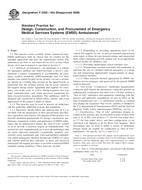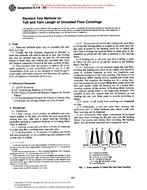1.1 This test method provides dc permeameter tests for the basic magnetic properties of materials in the form of bars, rods, wire, or strip specimens which may be cut, machined, or ground from cast, compacted, sintered, forged, extruded, rolled, or other fabricated materials. It includes tests for determination of the normal induction under symmetrically cyclically magnetized (SCM) conditions and the hysteresis loop (B-H loop) taken under conditions of rapidly changing or steep wavefront reversals of the direct current magnetic field strength.
1.2 This test method shall be used in conjunction with Practice A34/A34M.
1.3 This test method covers a range of magnetic field strength in the specimen from about 0.05 Oe [4 A/m] up to above 5000 Oe [400 kA/M] through the use of several permeameters. The separate permeameters cover this test region in several overlapping ranges.
1.4 Normal induction and hysteresis properties may be determined over the flux density range from essentially zero to intrinsic saturation for most materials.
1.5 Recommendations of the useful magnetic field strength range for each of the permeameters are shown in Table 1 . Also, see Sections 3 and 4 for general limitations relative to the use of permeameters.
1.6 The symbols and abbreviated definitions used in this test method appear with Fig. 1 and in appropriate sections of this document. For the official definitions, see Terminology A340. Note that the term flux density used in this document is synonymous with the term magnetic induction.
1.7 Warning-Mercury has been designated by EPA and many state agencies as a hazardous material that can cause central nervous system, kidney, and liver damage. Mercury, or its vapor, may be hazardous to health and corrosive to materials. Caution should be taken when handling mercury and mercury-containing products. See the applicable product Material Safety Data Sheet (MSDS) for details and EPA's website (http://www.epa.gov/mercury/faq.htm) for additional information. Users should be aware that selling mercury or mercury-containing products, or both, in your state may be prohibited by state law.
1.8 The values and equations stated in customary cgs-emu and inch-pound or SI units are to be regarded separately as standard. Within this standard, SI units are shown in brackets except for the sections concerning calculations where there are separate sections for the respective unit systems. The values stated in each system may not be exact equivalents; therefore, each system shall be used independently of the other. Combining values from the two systems may result in nonconformance with this standard.
1.9 This standard does not purport to address all of the safety concerns, if any, associated with its use. It is the responsibility of the user of this standard to establish appropriate safety and health practices and determine the applicability of regulatory limitations prior to use.
TABLE 1 Permeameters
| Permeameter | Useful Magnetic Field Strength RangeA | H Measuring DeviceB |
Reluctance Compensation |
Magnetizing Coil Surrounds Specimen |
References | |
|---|---|---|---|---|---|---|
| Oe | kA/m | |||||
| Babbit | 40/1000 | 3.2/80 | I, HC | yes | yes | (1,2) |
| Burroughs | 0.1/300 | 0.008/24 | I | yes | yes | (1,3,4,5) |
| Fahy SimplexC | 0.1/300 | 0.008/24 | HC | no | no | (1,4,5,6,7) |
| Fahy Simplex Super H adapterC |
100/2500 | 8/200 | HC | no | no | (1,3) |
| Full range | 0.05/1400 | 0.004/112 | HC | yes | yes | (1,8) |
| High H | 100/5000 | 8/400 | FC | yes | no | (1,5,7,9) |
| Iliovici | 0.5/500 | 0.04/400 | I, HC | yes | yes | (4,10,11) |
| IEC Type A | 0.1/2500 | 0.008/200 | HC, HP | no | yes | IEC 60404-4 |
| IEC Type B | 0.1/630 | 0.008/50 | RCC | no | no | IEC 60404-4 |
| Isthmus | 100/20 000+ | 8/1600+ | HC, HP | no | no | (1,4,12,13) |
| MH | 0.1/300 | 0.008/24 | FC | yes | yes | (1,6,14) |
| NPL | 0.5/2500 | 0.04/200 | I, HC | yes | yes | (15) |
| Saturation | 100/4000 | 8/320 | HC | no | yes | (5,16,17) |
A Although the permeameters are capable of being used at the lower end of the measurement range, the measurement accuracy is reduced.
B I-magnetizing current; HC-fixed H coil; FC-flip coil; HP-Hall probe; RCC-Rogowski-Chattock coil.
C Fahy permeameters require a standard of known magnetic properties for calibration of the H coil.

Note –
A1-Multirange ammeter (main current)
A2-Multirange ammeter (hysteresis current)
B-Flux density test position for Switch S3
F-Electronic Integrator
H-Magnetic field strength test position for Switch S3
N1-Magnetizing coil
N2-Flux sensing (B) coil
N3-Magnetic field strength sensing coil
R1-Main current control rheostat
R2-Hysteresis current control rheostat
S1-Reversing switch for magnetizing current
S2-Shunting switch for hysteresis current control rheostat
S3-Integrator selector switch
SP-Specimen
FIG. 1 Basic Circuit Using Permeameter
Product Details
- Published:
- 10/01/2011
- Number of Pages:
- 13
- File Size:
- 1 file , 190 KB


